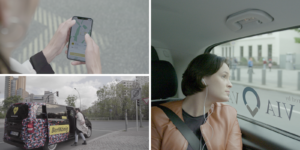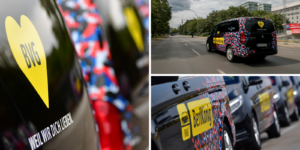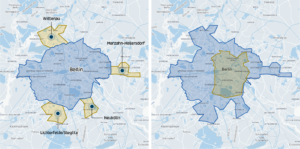As the coronavirus pandemic began sweeping across cities around the world, global use of public transportation unsurprisingly started declining. More residents began practicing social distancing and sheltering in place, leaving normally packed buses and trains all but empty. It was no different in Berlin as leaders with the Berliner Verkehrsbetriebe (BVG) watched their bustling public transport network quickly lose riders.
“With COVID-19 spreading rapidly in Germany, the city government of Berlin decided to implement comprehensive contact bans, meaning that all gatherings with more than two people were prohibited,” explains Dr. Henry Widera, CIO at BVG.
“Most of the people who can, work from home, and leisure activities were reduced to a minimum. That led to an strong decline of passenger numbers in our trains and busses, as well as in the BerlKönig, the ride sharing service we are offering together with Via.” The BerlKönig is the world’s largest microtransit network, providing on-demand public transportation throughout Berlin with more than 100 shared shuttles. But as ridership declined, Widera and his colleagues saw an opportunity to make a few important changes with their flexible BerlKönig system, altering services in a matter of days to serve the city’s most essential employees.

1. Provide healthcare workers with free on-demand transportation.
While a majority of Berlin’s citizens sheltered in place and avoided close contact with others, there was still an essential group of residents who needed reliable transportation: healthcare workers. “We now have the situation that the demand for public transport is collapsing, but at the same time public transport is vital to all those who are working in system-relevant sectors, especially in the health and medical sector,” Widera said.
“Thus, we decided to adapt our BerlKönig service to an exclusive and free of charge service to those passengers working in health and medical institutions – the heroes of our time.” Starting March 25, the BerlKönig suspended regular operations, exclusively providing free on-demand rides for medical and nursing staff during night-time hours. Authorized healthcare workers were only asked to provide documentation to register for the service.
“Thanks to the very good cooperation with [Via] and its digital capabilities, we were extremely flexible to shift our service quickly. Our common service with busses and trains, which is obviously aimed for transporting a large number of people on fixed routes, does not provide such flexibility. Technology, thus, played the crucial role in making the new service possible.”

2. Adapt the BerlKönig’s services to meet new needs.
Using the system’s nimble technology, the BerlKönig was able to make some fast changes to better focus on essential employees, and to minimize person-to-person contact.
First, because the on-demand service was going to be used exclusively by registered medical staff, the BerlKönig was able to develop a verification process that provided qualified residents a unique code to activate the free rides.
Second, in an effort to accommodate social distancing, all shared shuttles were automatically capped at 50 percent capacity, allowing only half of the normal amount of passengers to share a ride.
“As the public transport authority, we are committed to provide our city and its inhabitants with the best possible mobility, no matter which time or situation,” Widera explained. “Thus, it was our commitment in this critical time to uphold our services, even though the demand declined. “We also decided to give back to those who are working on our healthcare, and are therefore most important to our community. Together with our partner [Via], we developed the adapted service and presented it to the relevant stakeholders at the city government, which all supported the plan vehemently. We contacted important institutions of the health and medical sector and adapted the service area and times to their needs.”

3. Change service zones and hours of operation.
Because healthcare employees work long hours and not every hospital in Berlin falls within the BerlKönig’s service zone, the BVG needed to make some fundamental changes to its on-demand service. Working directly with healthcare facilities and hospitals, the BVG learned where the biggest needs were for healthcare workers across Berlin. Expanding its zones to reach the city outskirts and additional hospitals, the service area now includes the entire S-Bahn ring and parts of Steglitz, Lichtenrade, Neukölln, Marzahn, Wittenau and Tegel. The new service area of the BerlKönig Sonderfahrten includes 75 percent of Berlin hospital beds. In addition, the service now operates from 9 p.m. to 8 a.m., transporting workers during shift changes when and where transport is needed most.
Medical workers love riding the BerlKönig.
Widera says the response to the new service has been incredibly positive, and the volume of riders thus far shows that the service meets demand. And beyond metrics, riders have been tweeting at the BVG online, and sharing feedback via email. As these three medical professionals put it:
- “…On behalf of all nursing staff and medical staff: I would like to thank you for what you are doing for us, so we can keep going on the front lines! Through this you are also everyday heroes!”
- “Thanks so much, what an enormous relief. Due to the thinning-out of regular public transit, reaching early shifts in the hospital would otherwise hardly be possible.”
- “My fiance was picked up at home this morning by the BerlKönig and taken to her early shift at Charite — for free! Big shout out to BVG for this service. A great sign of appreciation and gratitude in these times.”



%206.png?width=71&height=47&name=The%20Buzz%20Blog%20Hero%20(1750%20x%201200%20px)%206.png)